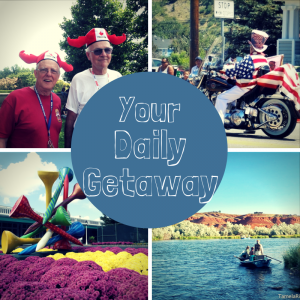Tamela Rich's Blog, page 10
July 8, 2014
Chattanooga, You’re More than Your Tourist Traps!
Headed from Cherokee, North Carolina to Chattanooga, Tennessee I started seeing billboards for Rock City and its sister properties on Lookout Mountain everywhere. They gave me a Wall Drug Store feeling.
If you don’t know what I mean by that, you’ve never been within 500 miles of South Dakota. Promotions for the tourist trap (I say that with love) are painted on signs, barns, derelict farm equipment, and fence posts every mile or so along The Mount Rushmore State’s Interstate 90. They’re elsewhere, of course, even as far away as Antarctica (9333 miles).
I mention Wall Drug because, fun as it is, it’s overblown. I was concerned that the attractions on Lookout Mountain might fall into that category. In fairness, it would be hard to live up to that level of hype.
International Towing and Recovery Museum
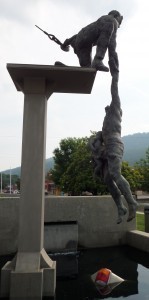
“Monument to the Fallen.” Be sure to note the headlight of the car under the water. The towing operator is rescuing the driver and a child
I couldn’t decide if I wanted to stop at Lookout Mountain, but there was no doubt that I wanted to see the International Towing and Recovery Museum, less than two miles away. It’s the kind of obscure roadside attraction (too obscure to be called a tourist trap) that always calls to me.
Alas, by the time I pulled in, they were locking the doors, but the sun was just about right for these shots.
According to the website, “The Museum exhibits tow trucks and towing equipment dating back to 1916…The Museum also includes a theater, a library, and a unique gift shop that sells souvenirs related to the towing and recovery industry.”
Who knew?
And who knew that tow trucks had their own event at Talladega Speedway? One of the record-holders raced at 109.33 mph. Holy cow. Click here for the official video.
At first I was taken aback by the “Wall of the Fallen” inductees, listed on plaques surrounding the monument pictured left. Those honored on the Wall lost their lives rescuing others. The 2014 honorees include an Irishman and a Canadian in addition to four Americans.
On reflection, I thought when’s the last time we considered the dangers that tow truck operators and other first responders face while getting us out of dangerous situations?
And aren’t you glad someone knows how to operate the Jaws of Life?
Next time I’m in Chattanooga (and yes, I will be back!) I’ll be sure and take the full tour.
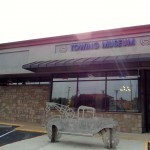
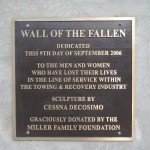
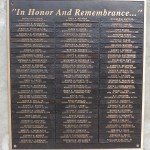
Eat at Sluggo’s North Vegetarian Cafe
 Since I missed the chance to tour the museum, I whipped out my phone and looked for a vegan restaurant. No, I’m not vegan, but I figured a town the size of Chattanooga would have one. Intestines appreciate green food and fiber.
Since I missed the chance to tour the museum, I whipped out my phone and looked for a vegan restaurant. No, I’m not vegan, but I figured a town the size of Chattanooga would have one. Intestines appreciate green food and fiber.
Both Yelp and Urban Spoon recommended a place I wouldn’t have chosen based on its name. Sluggo’s? Sounds like a garden pesticide (and it is!)
But oh, am I ever glad I went with the recommendations.
I appreciate when chefs go with the strengths of plant foods instead of trying to make veggies, fruits and grains taste like flesh and dairy.
Sluggo’s offers plenty of gluten-free choices and it even offers packets of Stevia with the other condiments—I pack my own Stevia since it’s hard to find on the road.
Sluggo’s itself has a legitimate hippy vibe and played music that might have been Bob Dylan’s or one of his proteges. I should have asked.
Beautiful bridges and a vibrant riverside
The route from the Towing & Recovery Museum to Sluggo’s takes you through downtown and over the Tennessee River. What a sight! The Market Street draw bridge and Walnut Street “camelback truss” bridge are freshly painted with terrific views.
If you visit Chattanooga, allow time to walk across the river on Walnut Street Bridge, one of the world’s longest pedestrian bridges.
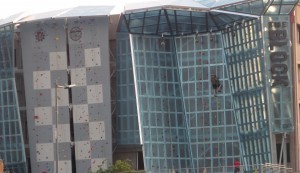
See the climbers on the outside wall of this parking deck?
I hadn’t done any research on Chattanooga, besides the Towing and Recovery Museum, and I had plenty of time before I needed to arrive at the BMW Riders Association Rally in Birmingham, Alabama so I cast my traveling fortunes to the Universe and poked around on the riverfront for a bit. It was irresistible.
You can always judge the spirit of a city by what happens after business hours on a weekday. I found Chattanooga on a Wednesday night to be one of the most vibrant I’ve visited.
Sure, lots of places are designed with tourists in mind, like the Tennessee Aquarium, Chattanooga Choo Choo, Delta Queen and Chattanooga Ducks, but it also has plenty of open-air eateries, parks, walkways and a bike sharing program for residents.
I was delighted to see that they dual-purposed a parking garage exterior as a rock climbing center. Ingenuity!
No longer the “Dirtiest city in America”
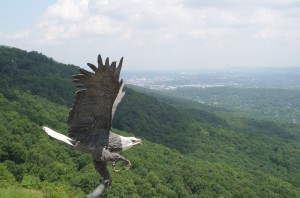
View of Chattanooga’s Tennessee River from Lookout Mountain
I read in a magazine at Sluggo’s that in 1969 Walter Cronkite called Chattanooga the “Dirtiest city in America.” The air was so polluted that people had to drive with their headlights on to see in broad daylight. Now it’s one of the country’s most progressive.
How’d it manage a turnaround of such magnitude? Learn about its inclusive citizen-planning process in this video (sorry, no embed link). For anyone in the change management or community-building business you’ll be inspired by how they made a 60-person steering committee work. “Barriers melted when people came together,” said one civic leader.
And for anyone who thinks privatization is ALWAYS best, take note: Chattanooga’s city-owned Electric Power Board runs its own network, offering higher-speed service than any of its private-sector competitors can manage. Who can say “virtually unlimited bandwidth” without grinning?
Chattanooga officials say the network has helped spark a burgeoning local tech scene and the relocation of a number of businesses, drawn by both the fast Internet and the reliability offered by the smart grid. ~CNN Money
I would move to Chattanooga in a skinny minute!
Rock City
I reluctantly left the riverside and went back across town to Rock City to scope out the hype, knowing it would soon close for the evening. I wanted to decide whether to zip out of town the next morning or stick around to sample its charms with the rest of the tourists.
I ran into a fellow BMW motorcyclist in the parking lot of Ruby Falls, which you approach near the foot of Lookout Mountain. Sure enough, he was also headed to Birmingham for the rally. He had just seen the underground waterfall (Ruby Falls) and gave me his report.
So did I stay or go to Rock City the next day? Stay tuned.

July 1, 2014
Cherokee and the Great Smoky Mountains National Park
As I ascended the foothills toward Cherokee and the Smokey Mountains on my motorcycle, a refreshing breeze of magnolia and jasmine wafted through my visor. It was a gift that folks in their hermetically sealed cars missed altogether. I drank in that lovely scent, which reminded me of the importance of belly breathing.
I was emotionally and physically exhausted by the two-month process of moving out of our suburban home of 26 years as we downsized to an urban townhouse. The magnolia and jasmine induced my decompression cycle.
Camping in the Great Smokey Mountains National Park
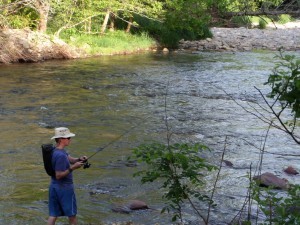
Matt fishing in the Raven Fork River.
Matt and I decided to take Memorial Day off together before I headed further south on my BMW and he returned to his office. We stayed at the Cherokee/ Great Smokies KOA in a Deluxe Cabin that faced the morning sun. The Raven Fork River flowed below our deck.
In the podcast (above), I recorded several minutes of the Raven Fork caressing the riverbank. I also included a guided meditation designed to help you drop your cares into the river and focus on something joyful. I invite you to enjoy it as often as it calls to you—download it if you’d like.
By Monday, when most campers were headed home from the holiday weekend, we were rested and ready to explore.
The best way to reach most of what the Smokies and Blue Ridge Mountains offer is via the Blue Ridge Parkway. The Parkway connects North Carolina’s Great Smoky Mountains and Virginia’s Shenandoah National Parks; Cherokee is its southern terminus.
Cherokee’s history
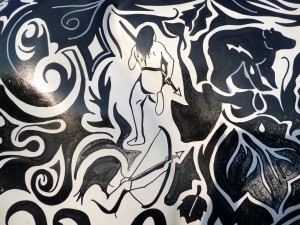
Detail of “Language Bear” public art bear by Billie Jo Rich
Cherokee is named for the Native Americans who have lived in the region for over 11,000 years. Although you’ll hear people refer to their tribal lands as the “Cherokee Reservation,” the proper term is the “Qualla Boundary.” The Boundary is adjacent to the Great Smokey Mountains National Park and defines lands held in trust by the federal government for the Eastern Band of Cherokee Indians, a sovereign nation.
The Eastern Band of Cherokee Indians worked against expatriation, which is referred to as the Trail of Tears. 16,000 Cherokees were forced to walk west for six months across 1,200 miles. Nearly one in four died along the way.
Learn more about Cherokee history and culture at the Museum of the Cherokee Indian.
Oconaluftee Visitor Center
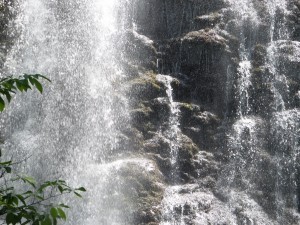
Mingo Falls is in the Great Smokey Mountain National Park
You could fill a week with places to see and things to do within 50 miles of the Cherokee KOA; here’s what we did in a day.
The Great Smokey Mountains National Park is the most visited of our country’s 58 national parks and boasts over 800 miles of hiking trails. We visited its Oconaluftee Visitor Center, with 6,300 square feet of educational displays and services featuring the rich cultural history of the Smokies: pre-historic culture, legends and artifacts, the arrival of European settlements, logging, the creation of the national park and the contributions of the Civilian Conservation Corps, of which my grandfather was one.
Be sure to pick up a map of the park and spend an hour or so visiting the adjacent Mountain Farm Museum and Mingus Mill.
The rangers and volunteers know virtually everything about the flora, fauna, history and culture of the area. Since I was soon headed south to Alabama’s de Soto Falls, named for Hernando de Soto, I was interested in the Spanish explorer’s 1540 history in the Smokies. I took a chance and asked a ranger if he knew anything about this period of time.
By luck, he who had recently read a biography about the de Soto. He told me stories of greed and cruelty to rival any I’d heard about Hernan Cortes, who felled the Aztec Empire. If you’re not in the habit of chatting up park rangers, you’re missing out on a treat. They have dedicated their professional lives to making your visit a memorable experience.
Clingman’s Dome and rainforest
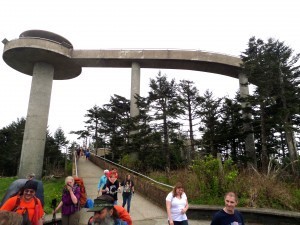
You can see for 100 miles from Clingman’s Dome Observation Deck, provided the air is clean
Clingman’s Dome was next on our agenda. Since we were feeling fresh from our rest and relaxation at the campground, we decided to take the steep half-mile hike up to the observation tower, which, according to the National Park Service, is the highest point in the park. There are several benches along the way for rests and I’ll admit I needed a few.
The Appalachian Trail crosses Clingman’s Dome and is the highest point from Georgia to Maine. We met several through-hikers at the base of the observation tower and wished them well on their adventure (see them at the bottom of the picture to the right).
We often equate “rainforest” to the Amazon, but Clingman’s dome is home to a coniferous rainforest. The cool, wet conditions are ideal for spruce and fir. You’ll be walking through clouds, and temperatures are commonly 10-20 degrees (F) cooler there than at the lowlands. Be sure to pack a sweater or jacket, even in summer. If you’re lucky, and the clouds and air pollution are out of the way, you’ll be able to see mountain views for more than 100 miles from the 360-degree observation tower.
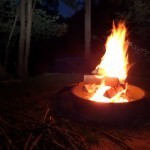 Back at our cabin for one last night, we built a fire and talked about the important things in life that are too often neglected in the daily bustle. Although we could have stayed on at the campground for a week, we were rested enough to get on with our lives.
Back at our cabin for one last night, we built a fire and talked about the important things in life that are too often neglected in the daily bustle. Although we could have stayed on at the campground for a week, we were rested enough to get on with our lives.
The staff at the campground told me that the only complaint they hear about vacationing Cherokee is the difficulty of finding a phone or wifi signal.
“Problem?” I asked. “That’s why we came here.”
Readers, I hope you’ll listen to the podcast above at a quiet time when you can follow the guided meditation to relax and let go. We all need help from time to time. You can share it with friends and/or subscribe in iTunes and Stitcher.

June 28, 2014
Planning a Family Vacation Road Trip? Here’s My Advice
July is prime family vacation and road trip season. I’m a people watcher, and since I am often alone on the road I get plenty of opportunities to observe families on vacation.
Eavesdropping on conversations, I notice that the destination and the amount of money parents spend on their vacations has no bearing on whether the kids whine or complain.
Flexibility: The key to a great family vacation
The happiest families on the road are those who allow flexibility into their schedules.
I once heard a mom in a restaurant handle an off-itinerary request beautifully. Her little girl of about ten asked if they could pan for gold at the Black Hills Mining Museum in Lead, SD. The mom said that this would be her daughter’s only chance for the next 24 hours to change the family schedule. “Do you really want to use your chance on this?”
The little girl looked over at her younger brother, who was clearly not interested in panning. Maybe she thought she could get him to use his chance on this instead of her. No dice.
She thought about it, and said, “No, I think I’ll wait and see if something more fun comes along later.”
Set the ground rules
No doubt this family had established ground rules for their vacation. The little girl knew ahead of time that she had one chance in a day to make the vacation just what she wanted it to be.
What a difference in that relationship than the one where a parent just puts the hammer down. Granted, sometimes there simply isn’t time to make a detour, but I bet this family had that contingency factored into their ground rules, too.
Live and learn. I wasn’t that kind of parent either.
Family vacations on a budget
I was quoted in US News & World Report on the subject of family vacations. Here’s the article, which tells how to take a family vacation on $500/$1,000/$5,000.
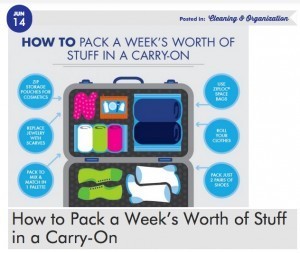 If you’re fretting about what to pack for your vacation, perhaps this article from Bed Bath & Beyond will inspire you to pack LESS. Yours truly was quoted, although the writer went a bit overboard with the product endorsements; I use roll sacks instead of Ziplock bags.
If you’re fretting about what to pack for your vacation, perhaps this article from Bed Bath & Beyond will inspire you to pack LESS. Yours truly was quoted, although the writer went a bit overboard with the product endorsements; I use roll sacks instead of Ziplock bags.
My best advice about packing? Consider your wardrobe like Lego pieces. Everything should go with everything else. You should be able to pick any top and any bottom. Oh, and you don’t need more than three pairs of underwear! More in the article, of course.

June 22, 2014
FDR’s Little White House and the Joy of Solo Travel
Coming home from my recent swing through the Deep South I found myself northeast of Columbus, Georgia on a byway. I came upon a brown highway sign—always a welcome sight to my eyes—that said “FDR’s Little White House 15 miles.” The arrow pointed left.
I smiled broadly, having a vague memory of such a place from the Eleanor Roosevelt mysteries I once borrowed from the public library’s audio book collection. I made the left turn and mentally recalculated the rest of my itinerary.
And that, friends, is one of the many beauties of solo travel: no one to consult or negotiate with when something you want to do comes across your path.
Two tips for getting the best out of a solo vacation:
Be flexible. Flexibility and freedom are the top perks to solo travel. Leave plenty of time for serendipitous moments at a diner or museum and roadside attractions that pop up unexpectedly.
Don’t buy your tickets to shows and attractions in advance. Granted, some tickets sell out quickly, but you don’t want to anguish over the decision to do something you’ve already paid to do and something else you’d rather do once you are on your trip.
Stop at Manchester’s President Theater first
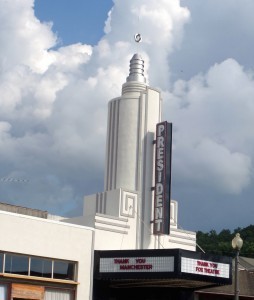 I arrived too late in the day to take the Little White House tour, so I stopped at Manchester, where I unexpectedly came upon the President Theater. I didn’t get a chance to see inside the theater, still being renovated, but the outside is striking—I love Art Deco.
I arrived too late in the day to take the Little White House tour, so I stopped at Manchester, where I unexpectedly came upon the President Theater. I didn’t get a chance to see inside the theater, still being renovated, but the outside is striking—I love Art Deco.
Local history has it that Roosevelt took a phone call in Manchester from New York Democratic Party operatives in 1928 that led to him (successfully) running for governor.
After dinner I traveled the remaining five miles to Warm Springs, home of the Little White House, and grabbed a hotel room, washed some clothes and answered email.
FDR’s Little White House: worth a detour
According to the official website, FDR first came to Warm Springs in 1924 hoping to find a cure for polio, which struck him in 1921. “Swimming in the 88-degree, buoyant spring waters brought him no miracle cure, but it did bring improvement.”
The excellent museum on the property even has footage of Roosevelt frolicking in the springs with children who were there for the cure. It took my modern sensibilities a moment to adjust to the sight of kids “ganging up” to push him under the water’s surface, only to see him emerge from the depths, laughing like he was a schoolboy too.
FDR lived at a pivotal time in world history and the museum shows him to us through the lens of the Great Depression. Technology and manufacturing techniques were exploding in capabilities and their ability to shift public priorities in both the United States and abroad. In an odd coincidence, I had watched The History Channel’s 2014 series The World Wars, over Memorial Day Weekend, so I was primed for the experience, but still had plenty to learn.
Take at least an hour to view the exhibits and another 14 minutes to see the video narrated by Walter Cronkite (sorry, no embed link but ). Be sure to read the captions of all photos.
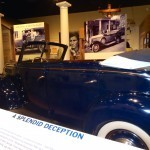
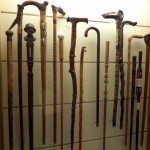
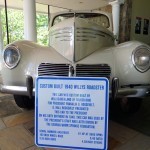
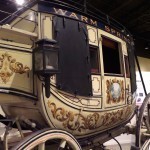
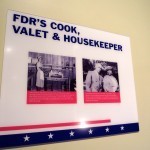

Roosevelt slept in a twin bed and died at Warm Springs
FDR built his retreat in 1932 as he began campaigning for the presidency, only to name it The Little White House after he won the office. In the 21 years he owned the property he visited 41 times. Roosevelt frequently brought along dignitaries and cabinet members, who stayed in a guest house on the property. The Marines who patrolled the area slept in tents.
The Little White House is really a one-story cottage of only 1300 square feet with six rooms. FDR slept in a twin bed, pictured below.
While posing for a portrait on April 12, 1945, he told the artist “Just fifteen more minutes.” He suffered a stroke fifteen minutes after speaking those words and died shortly thereafter. The watercolor work in progress is preserved there as “The Unfinished Portrait.” (See my snapshot of it in the bottom right of the gallery below.)
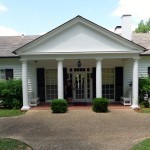
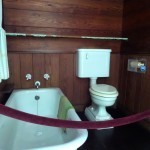
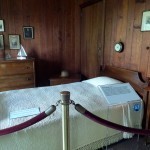
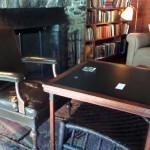
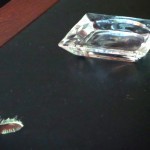
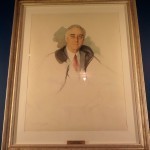
Memories from my childhood surfaced
Just before leaving on my Deep South Roadtrip, I wrote about the emotional difficulties of giving away so many treasures I had inherited from my grandparents when we downsized to an urban townhouse. Well, my grandparents toured the Depression Era Little White House with me in spirit. Nothing significant has been changed since FDR’s death.
The furnishings, including glassware, appliances and an insecticide pump, brought back childhood memories of my grandparents’ home. Mamaw was handy with needles of all types—sewing, knitting and embroidery—and Roosevelt’s linens reminded me of hers.
It occurred to me that FDR’s New Deal probably kept my grandparents alive. Papaw, one of the eldest children of twelve, signed on to the Civilian Conservation Corps (CCC), which was part of Roosevelt’s New Deal. The CCC taught Papaw valuable job skills and sent money back to his impoverished farming family. In tribute to the president, one of Papaw’s brothers was named Franklin Delano Roosevelt—we called him Uncle Rosie.
In today’s political environment, they all would have been left to starve.
Click here to view the embedded video.
Roosevelt’s polio was more than a personal crisis
Roosevelt bought the property and created the Warm Springs Foundation in 1927 to establish the country’s first hospital dedicated to caring for polio victims. In 1938, the foundation announced the creation of the National Foundation for Infantile Paralysis, or NFIP, which eventually became today’s March of Dimes.
I can only speculate how differently the journey out of the Great Depression would have been charted had Roosevelt been spared that crippling disease. Without polio he wouldn’t have come to Warm Springs, in close proximity to rural folk without electricity, adequate schools and health care (see the note under FDR’s Ford in the pictures above). It’s not an overstatement to say that polio shaped his sensibilities and legislative priorities.
I’m sure he asked himself, as we all do, “Why me?” As the wonderful Paulo Coelho answers,
“There are moments when troubles enter our lives and we can do nothing to avoid them.
But they are there for a reason. Only when we have overcome them will we understand why they were there.”
~Paulo Coelho, The Fifth Mountain

May 21, 2014
Embrace Mindful Minimalism? Try Downsizing, Then We’ll Talk
I must’ve gotten too smug about downsizing to mindful minimalism.
Living off the back of a motorcycle for weeks at a time taught me to embrace mindful minimalism— I even facilitate a Mindful Minimalism workshop—but I had no idea that the process of downsizing would take such a toll.
Tamela, you silly goose, living off the back of a motorcycle is easy when you don’t have to throw anything away before you throttle up!
Suburbs to Townhouse

Sleek, yes. With NO storage to speak of.
As I reported to newsletter subscribers, January and February were a blur to me. I was felled by flu and walking pneumonia and didn’t work more than ten hours over the first six weeks of the year—an awful a way to marshal my strength for moving out of our suburban home of 26 years.
We found a marvelous place in the heart of the city and started moving mid-March. We are over the moon with our new urban digs!
Downsized digs.
Sleek digs with NO storage space to speak of. My spouse and I remind each other that we must learn to live like Swedes, which is a nod to Ikea, with a showroom floor plan demonstrating that it’s possible to live in 375 square feet and not have to share a bathroom with your neighbors down the hall.
Thankfully, we’ve been preparing to move since last year, starting with our closets. I donated a truckload of my clothes to charity. I’m not kidding…a true truckload. Before winter set in we made a lot of headway through the old shreddable tax records and college memorabilia, through my now-grown boys’ childhood toys, sports gear and so on. I felt virtuous (a sure warning sign of a hard fall, I see in retrospect).
I firmly believed I was ready to downsize, but it turns out that I didn’t have the emotional or physical stamina for the job. It’s the end of May and I’m still dealing with it.
26 years and 10,000 daily decisions

This is the only copy I have of this priceless treasure. The original is in the landfill.
I was quickly overwhelmed by the volume of family “heirlooms” and stored mementoes (oh, the macaroni art!) that stood between me and my new downsized life. If you’d bet me how much I’d saved, and we measured it in cubic feet, I’d have lost that bet by an order of magnitude.
My mom shipped some of those boxes of heirlooms to me 14 years ago when she retired and I never even opened most of them before hauling them to the attic. Now I wish I’d skipped the attic step and just donated them to Goodwill—I had no idea the emotional energy I required to deal with them, along with everything else.
Mom had lovingly wrapped each item and attached a handwritten note about where it came from and its family history. For example, two figurines came with a note about how her grandmother had taken her to a store and told her she could pick anything she wanted, and these figurines were her choice. What kind of brute can part with such treasure? A brute under severe storage constraint.
If something’s been in the attic for a couple of years and you haven’t missed it, you don’t need it.
I can’t blame the family heirlooms entirely for my grief. Most of the mess was of my own making because I saved too much along the way of raising children. Here’s a sample of the tough calls I had to make (not “we” because Matt was ready to toss all):
How many birthday cards should I save for each of the boys from their great-grandparents, grandparents and extended family? Dozens to choose from, but what criteria should I use for making the final cut? Should I look at each of them or just throw them all out?
How can I part with handmade treasures from my grandmother? She taught me to knit and crochet and I inherited over 100 needles and other tools plus afghans and garments for me and the boys. Anguish.
What is the honorable way to disencumber the costume jewelry passed down to me from my deceased mother-in-law? Should I keep any of it? If so, which pieces?
Which photographs of our offspring should we keep? OMG we must have photographed the boys’ every baby burp! Will I ever EVER take the time to digitize them?
How about all those VHS tapes of their soccer games and birthday parties? The money we spent on that big shoulder-mounted video camera should have been socked away in an IRA.
Books. We shan’t speak of these sacrifices. Let the wound heal.
Nothing’s Worth Anything

Carnival glass, anyone? Bueller…Bueller?
We must’ve thought we were royalty when we married in 1984. The Wedgwood, the sterling silver flatware, the crystal and other “must-haves” are antithetical to mindful minimalism and they’re not worth anything on the open market.
Use it or smelt it, Tamela.
The Depression Glass that my family has been passing down? No market for it. Not worth the cost to ship them to an eBay buyer.
Use it or donate it, Tamela.
The collection of “Occupied Japan” ceramics I’d forgotten in my attic? I decided I didn’t have time or energy to research which pieces are most valuable and which dealers are most trustworthy. Some eagle-eyed shopper at the Junior League Wearhouse will probably snap it up and be on Antiques Roadshow next year.
Have at it, sister.
Board games? Ha! Everything’s online now.
It’s the end of civilization as we know it, folks.
Yard Sale? Yuck!
I don’t even go to yard sales myself, so I wasn’t a highly successful seller. I actually told one woman who was trying to talk me down from a dollar to a quarter on a set of mugs that if I was going to give them away I would at least get a tax receipt for giving them to a charity!
Know what? That’s exactly where those mugs went.
Stay tuned for downsizing ruminations as I gain the time and clarity to share. This week, I’m headed out for a two-week motorcycle road trip!

May 5, 2014
Motorcycle Road Trip Itinerary: The Deep South
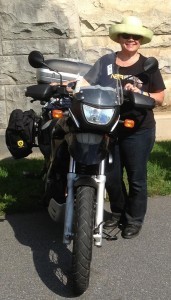 My first motorcycle road trip of 2014 takes me to the American Deep South. I’ve got lots in store for you, from roadside kitsch to fascinating people and places as I traverse North Carolina, South Carolina, Tennessee, Georgia, Alabama and Florida.
My first motorcycle road trip of 2014 takes me to the American Deep South. I’ve got lots in store for you, from roadside kitsch to fascinating people and places as I traverse North Carolina, South Carolina, Tennessee, Georgia, Alabama and Florida.
My kickstand’s up for Memorial Day weekend at the Great Smoky Mountain National Park in North Carolina and Tennessee. Did you know this is America’s most-visited national park?
DeSoto Falls: Did the Welsh land in Alabama before Columbus sailed in 1492?
En route to Birmingham I’ll hit Alabama’s DeSoto Falls, a beautiful waterfall with an intriguing folklore. Some believe that several small caves below the waterfall were part of a fort built by Welsh explorers led by Prince Madoc. The story goes that Madoc landed on Mobile Bay in 1170 C.E. and then made his way inland to reach the mountains of Alabama, Georgia and Tennessee.
Another legend says conquistador Hernando de Soto was the first European to see the falls—and the Mississippi River—in the 1540′s. Then again it might have been Tristan de Luna, another Spaniard, but the name tells you who won the publicity war.
Not sure a humble 21st century motorcyclist can sort out what historians and archeologists have been studying for decades, but I’ll give you a full report of what everyone agrees is a scenic wonder!
Little River National Preserve and the gravesite of typewriter inventor John Pratt
Just down the road, I’ll visit the Little River National Preserve. This gorgeous canyon is one of the deepest to be found east of the Mississippi River and is part of Lookout Mountain, which saw critical Civil War action. 
Another 28 miles south of the Preserve is the burial site of John Pratt, who invented the first commercially-viable typewriter before the Civil War. His contribution to the modern world can’t be over-estimate, although he is better known in England, where his device was called a “pterotype.” I don’t know how he came to be buried there, but I’ll be asking lots of questions and report back.
Storytelling at the BMW Rally (and some roadside giants) in Birmingham
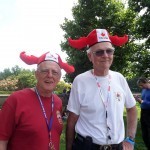
These Canadian rally goers cracked me up in 2012!
The centerpiece of this itinerary is the BMW Riders Association, which holds its national rally in Birmingham, Alabama.
We are going to have a great time at the rally with motorcycle storytellers Brian Slark, Sarah Schilke, Lisa Malachowsky, Troy Rice, Valerie Thompson and others who are still nailing down their plans. Rally goers will be entertained with stories ranging from road trip triumphs and tragedies to the history of Barber Vintage Motorsports Museum and racing at Bonneville Salt Flats. My TEDx co-presenter Neale Bayly and I will emcee the event and tell stories of our own.
If you have a story to tell, you can still make the lineup! I need your motorcycle-themed story by May 15. Details here.
I also plan to add to my Muffler Men photo collection in Birmingham. Stan the Tire Man is there with non-standard hands (both palms up).
Birmingham is home to three other giants, Miss Electra (atop the Alabama Power Building), Vulcan the Iron Man and a replica of the Statue of Liberty. I’m gonna have a field day getting pictures of all four *rubs hands together*!
Tuscaloosa for a tornado update
In 2011 a mile-wide, multiple-vortex tornado hit Tuscaloosa. Tornadoes topple just about anything in their paths and rumor has it that McAlister’s Deli turned one of its felled trees into a replica of its signature ice tea glass. If Roadside America reports it, I owe it to the rest of us to get a snapshot!
On a more somber note, the region was struck by tornadoes again this year and I’ll be talking to students at the University of Alabama about their involvement in both the 2011 and 2014 recovery efforts. Please email me if you know someone I should interview while there.
Florida’s panhandle
If severe weather and flooding don’t foil my plans, I’ll take a cave tour at Florida Caverns State Park. The cave has limestone stalactites, stalagmites, soda straws, flowstones and draperies. Here’s a quick video.
Funny side note: my spouse always teases me when I get excited about visiting new geological formations because I “only” got a B+ in university Earth Science. Matt is an engineer and I was a business major who hadn’t finished my science requirements when I reached my senior year. We can all agree that a B+ is a perfectly respectable grade, but he teases me because I had set my sights higher, expecting that particular course to safely cushion my GPA for the coveted cum laude honor on my diploma. I guess I thought I would be smarter as a senior than I was as a freshman (when most students take 101 courses) so I confidently predicted, “Oh that’s an easy A.”
Ha! I couldn’t always distinguish between igneous, sedimentary and metamorphic rock specimens, so my lab performance brought me down to a B+ and he never lets me forget it! Oh well, what really matters is that I did graduate cum laude AND thanks to travel, I’ve gotten much better with those specimens.
But I’m not a qualified “rock hound.”
Savannah, Georgia
 I never knew that Savannah, Georgia is America’s first planned city. General James Edward Oglethorpe (who founded the colony of Georgia) designated Savannah as the capital. He laid it out as a series of neighborhoods centered around 24 squares.
I never knew that Savannah, Georgia is America’s first planned city. General James Edward Oglethorpe (who founded the colony of Georgia) designated Savannah as the capital. He laid it out as a series of neighborhoods centered around 24 squares.
Movie fans know that Forrest Gump’s bench is on the square but the actual movie prop has now been moved to Savannah’s History Museum.
Also of note to my keen trivia sensibilities is The Pirates’ House (1754), an inn mentioned in Robert Louis Stevenson’s book “Treasure Island.” I’ll be sure to get snapshots of this and more!
Got a travel tip for this region? Don’t keep it to yourself, email it to me, please!

May 1, 2014
My TEDx Talk with Neale Bayly: Chance Encounters
When the organizers of TEDx Charlotte gave me and my friend Neale Bayly the opportunity to talk about the role that chance encounters have played in our lives we jumped right in.
Both Neale and I are motorcyclists but we’re full of contrasts: he’s male, I’m female; he’s been riding for 37 years and I for 5; he’s British, I’m a Yank; he belongs to the 200 m.p.h. club and I wouldn’t dream of trying!
Our TEDx talk explores what we have in common: people we met while astride our motorcycles who would change our lives profoundly. No spoilers here; you’ll have to watch our talk for the stories.
An unconventional TEDx format for unconventional speakers
You’ll notice our talk looks different from other TED Talks. When Neale and I arrived for our first TEDx coaching session we bantered for a few minutes about our experiences. We cut into each other’s stories with side remarks and “Oh, don’t forget to tell them that part.”
Banter.
After about seven or eight minutes of that Mike Watson and Winn Maddrey turned to each other in unison, nodded wordlessly in agreement, and then Winn said, “Do your talk just like that.” Keeping it on point and on schedule took a lot of practice, believe me.
I’d love for you to leave a comment with YOUR story of a chance encounter that changed your life.
Oh, and would you share this talk with your friends and social networks? Please, and thank you in advance.
Click here to view the embedded video.
If you’re new to TED and TEDx, here’s the skinny. TED is a nonprofit devoted to spreading ideas, usually in the form of short, powerful talks (18 minutes or less). TED began in 1984 as a conference where Technology, Entertainment and Design converged, and today covers almost all topics — from science to business to global issues — in more than 100 languages. Meanwhile, independently run TEDx events help share ideas in communities around the world.

April 19, 2014
I’ll be on Maggie Linton’s Sirius XM Show April 22
I’m looking forward to being on the one and only Maggie Linton Show !
You can catch me on Maggie’s show live on Tuesday, April 22. Tune in to SiriusXM channel 110 from 10:30-11:00 a.m. EST. The show repeats at 4:30 p.m. EST and Maggie will TAKE YOUR CALL!
Maggie is a book lover; she hosted a book radio program before getting her own, eponymous show.
We’ll be talking about the eight life lessons featured in my book, Live Full Throttle, my travels across the United States and Canada on my motorcycle, and what I’ve learned about living my best life from the people and places I’ve encountered.
Speaking of which, if you haven’t yet subscribed to The Daily Getaway, which is a photograph from my travels along with a quote or recollection delivered straight to your email inbox, what are you waiting for ? Hit this link now!

March 24, 2014
Join me for Storytelling at BMW Riders Association Rally
I’m looking forward to co-hosting “Tall Tales and Tell-Alls” with my friend and fellow TEDx Charlotte presenter, Neale Bayly (pictured above). If you’re a motorcyclist join us!
Because every motorcyclist has a story to tell:
The way you fixed a flat tire with a water bottle and duct tape
The time you ran out of gas on a Native American reservation, where you didn’t have permission to ride in the first place
How you got your mother-in-law to ride pillion after 25 years of trying to persuade you to give up your “dangerous habit”
Bringing your old airhead back to life
Now’s your chance to bring those stories to the main stage at the 42nd BMW Riders Association Rally at Barber Motorsports Museum.
Here’s how Tall Tales and Tell-Alls will work:
Each storyteller is allowed up to twenty slides, but can enter with a minimum of 10
Each slide will be on screen 30 seconds
This means each story will be between three and six minutes long
And yes, the slides will be on a timer
Here’s a video of me delivering a talk like this in Charlotte, NC.
Members can enter more than one story, but all stories must be accompanied by a PowerPoint deck with between 10-20 slides. NO EXCEPTIONS. No deck, no story time.
When and where
Date: Saturday, May 31
Time: 7:00
Place: Barber Motorsports
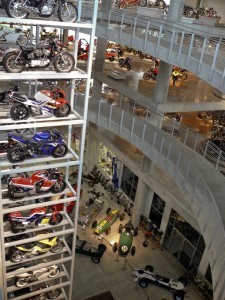 The Barber Motorsports Park is a 740 acres multi-purpose racing facility located on the eastern fringes of Birmingham, Alabama. It was built by George Barber, and includes the Barber Vintage Motorsport Museum, which has over 1200 vintage and modern motorcycles and race cars. The collection is the largest of its kind in the world; bikes range from 1902 to current-year production.
The Barber Motorsports Park is a 740 acres multi-purpose racing facility located on the eastern fringes of Birmingham, Alabama. It was built by George Barber, and includes the Barber Vintage Motorsport Museum, which has over 1200 vintage and modern motorcycles and race cars. The collection is the largest of its kind in the world; bikes range from 1902 to current-year production.
ALL SLIDES AND STORYTELLER BIOS MUST BE SUBMITTED BY APRIL 30 to: speaking(at)tamelarich.com
Tech Specs for your Slides
A single, strong, graphic image or succinct line of text will tell your story better than a crowded collage or packed paragraph. Rather than one complex slide, show several slides, each with one idea, image or data point.
Image size. Please design your presentation to fit within any of the following specs: WIDESCREEN HD (16:9 aspect ratio) : Min. 1920×1080 (hi res).
Title safe. Please keep a 10%-20% margin around your text, much as you would when typing on a piece of paper. This ensures that everyone will be able to read your slides.
Text size. Limit text to TWO lines or 5 bullet points. Text size will take care of itself when you do this. Slide image size Minimum font size: 1920 x 1080 (wide) 36 pts
Text clarity. Sans-serif fonts (like Helvetica) are easier to read at a distance than serif fonts (like Times New Roman).
Background. A simple, elegant background behind your text should be used to complement and enhance the readability of your words. If using a dark or black background, you may want to make the text bold.
Graphics and photos. Use high-resolution pictures and graphics. Full-quality photos from a digital camera will look better than images pulled off the web. If you pull images from the web, be sure they are licensed under Creative Commons for use.
Font files.To avoid last-minute glitches with your presentation onsite, font files should be embedded in your presentation file.
About Neale Bayly
With thirty-seven years in the saddle, Neale Bayly has ridden motorcycles in 45 different countries. The British-born Bayly works closely with America’s top motorcycle magazines and web sites, which send him all over the world to ride, test and report back on the best that a two-wheeled lifestyle offers.
His 2013 reality series “Neale Bayly Rides” made its debut on Speed Channel (now Fox Sports). The TV series showed Neale’s philanthropic side to the world. It documented a charity ride that he captained through the wilds of Peru, which culminated at a remote mountain orphanage which his charity, Wellspring International Outreach, supports.
When not traveling the world for assignments, Neale lives in Charlotte, NC, and spends his free time with his two sons, Luke and Patrick, riding and training on dirt bikes.
Twitter: @NealeBayly

February 16, 2014
Speaking at TEDx Charlotte this week. Watch online, if you can’t attend!
 Who doesn’t love a TED Talk? It’s been called “the ultimate brain spa.”
Who doesn’t love a TED Talk? It’s been called “the ultimate brain spa.”
TED is a nonprofit devoted to Ideas Worth Spreading. It started out in 1984 as a conference bringing together people from three worlds: Technology, Entertainment, Design. Today, TED talks have been viewed over a billion times online.
Delivering a TEDx talk with Neale Bayly
TEDx Charlotte is organized by a local team of volunteers. I’m over the moon to be presenting a TEDx talk with my buddy Neale Bayly this Friday, February 21 in Charlotte. This TEDx event’s theme is Unexpected: Converging Contradictions.
Neale and I will talk about “Chance Encounters that Changed Our Lives.”
Livestreaming information for your TEDx viewing party
You can watch from the comfort of the worldwide web by hitting this link https://new.livestream.com/tedx/TEDxCharlotte and pressing “play.” Better yet, invite some friends over and make it a shindig!
Talks begin at 1:00 p.m. and Neale and I will be “somewhere” between then and 5:00 EST. There will be seven other speakers, plus performing arts and other delights to keep you inspired and entertained.
About Neale Bayly
Neale is a Philanthropic Adventure Motorcyclist. If you are at all connected to motorcycling, you’ve seen Neale’s work with America’s top motorcycle magazines and web sites. Assignments send him all over the world to ride, test and report back on the best that a two-wheeled lifestyle offers. Neale and I teamed up to cover the 2012 and 2013 GS Trophy trials at the BMW Performance Center in Greenville, SC. Neale shoots the pictures, I write the stories.
His 2013 reality series “Neale Bayly Rides” made its debut on Speed Channel (now Fox Sports). The TV series showed Neale’s philanthropic side to the world. It documented a charity ride that he captained through the wilds of Peru, which culminated at a remote mountain orphanage which his charity, Wellspring International Outreach, supports. Like me, Neale lives in Charlotte, NC. He is a devoted father to his two sons, Luke and Patrick.
Here’s a video to acquaint you with this big-hearted friend and now co-presenter at TEDx Charlotte.
Click here to view the embedded video.


